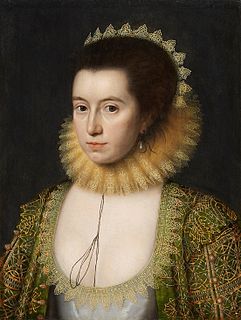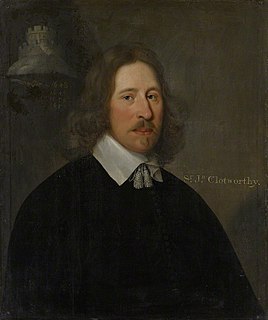Notes
This article needs additional citations for verification .(September 2014) |
- ↑ "No. 25021". The London Gazette . 30 September 1881. p. 4891.
- ↑ "No. 21167". The London Gazette . 31 December 1850. p. 3537.
Baron Hothfield, of Hothfield in the County of Kent, [1] is a title in the Peerage of the United Kingdom. It was created in 1881 for Sir Henry Tufton, 2nd Baronet, who was appointed Lord Lieutenant of Westmorland the same year and who also served briefly as a government whip in the Liberal administration of 1886. His eldest son, the second Baron, notably served as Mayor of Appleby, Westmorland. On the death of his son, the third Baron, in 1961, this line of the family failed. The late Baron was succeeded by his first cousin, the fourth Baron. He was the only son of the Hon. Sackville Philip Tufton, second son of the first Baron. On his death in 1986 this line of the family also failed and the titles passed to his first cousin, the fifth Baron. He was the eldest son of the Hon. Charles Henry Tufton, third son of the first Baron. As of 2017 [update] the titles are held by his son, the sixth Baron, who succeeded in 1991.
The Tufton baronetcy, of Appleby Castle in the County of Westmorland, [2] was created in the Baronetage of the United Kingdom in 1851 for Richard Tufton. He was the reputed natural son of Henry Tufton, 11th and last Earl of Thanet, who devised the substantial Tufton estates on him. He was succeeded by his son, the aforementioned second Baronet, who was raised to the peerage in 1881.
The family seat now is Drybeck Hall, near Appleby-in-Westmorland, Cumbria. The former was Skipton Castle, sold by the third Baron in 1956.
The heir apparent is the present holder's son, Hon. William Sackville Tufton (born 1977).
The heir apparent's heir apparent is his son, Samuel James Tufton (born 2009).
This article needs additional citations for verification .(September 2014) |

Earl Grey is a title in the peerage of the United Kingdom. It was created in 1806 for General Charles Grey, 1st Baron Grey. In 1801, he was given the title Baron Grey of Howick in the County of Northumberland, and in 1806 he was created Viscount Howick in the County of Northumberland, at the same time as he was given the earldom. A member of the prominent Grey family of Northumberland, Earl Grey was the third son of Sir Henry Grey, 1st Baronet of Howick.

Lady Anne Clifford, Countess of Dorset, Pembroke and Montgomery, suo jure 14th Baroness de Clifford was an English peeress. In 1605 she inherited her father's ancient barony by writ and became suo jure 14th Baroness de Clifford. She was a patron of literature and as evidenced by her diary and many letters was a literary personage in her own right. She held the hereditary office of High Sheriff of Westmorland which role she exercised from 1653 to 1676.

Earl Ferrers is a title in the Peerage of Great Britain. It was created in 1711 for Robert Shirley, 14th Baron Ferrers of Chartley. The Shirley family descends from George Shirley of Astwell Castle, Northamptonshire. In 1611 he was created a Baronet, of Staunton Harold in the County of Leicester, in the Baronetage of England. He was succeeded by his son Henry, the second Baronet, who married Lady Dorothy Devereux, daughter of Robert Devereux, 2nd Earl of Essex. On the death of her brother Robert Devereux, 3rd Earl of Essex, she became the youngest co-heir to the baronies of Ferrers of Chartley and the barony of Bourchier, which had fallen into abeyance on the death of the third Earl. Shirley was succeeded by his eldest son, the third Baronet. He died unmarried and was succeeded by his younger brother, the fourth Baronet. He was imprisoned in the Tower of London by Cromwell and died there in 1656. On his death the title passed to his eldest son, the fifth Baronet. He died at an early age and was succeeded at birth by his posthumous son, the sixth Baronet.

Baron de Clifford is a title in the Peerage of England. It was created in 1299 for Robert de Clifford (c.1274–1314), feudal baron of Clifford in Herefordshire, feudal baron of Skipton in Yorkshire and feudal baron of Appleby in Westmoreland. The title was created by writ, which means that it can descend through both male and female lines. The Norman family which later took the name de Clifford settled in England after the Norman Conquest of 1066 and was first seated in England at Clifford Castle in Herefordshire. The first Baron served as Earl Marshal of England but was killed at the Battle of Bannockburn in 1314. His 8th generation descendant the 11th Baron, was created Earl of Cumberland in 1525, whose grandson the 3rd Earl was a noted naval commander. On the latter's death in 1605 the earldom passed to his younger brother, the 4th Earl.

Earl of Granard is a title in the Peerage of Ireland. It was created in 1684 for Arthur Forbes, 1st Viscount Granard. He was a lieutenant-general in the army and served as Marshal of the Army in Ireland after the Restoration and was later Lord Justice of Ireland. He had already succeeded his father as second Baronet of Castle Forbes and been created Baron Clanehugh and Viscount Granard in 1675, also in the Peerage of Ireland. The Baronetcy, of Castle Forbes in county Longford, was created in the Baronetage of Nova Scotia on 29 September 1628 for his father, Arthur Forbes.

Lord Napier, of Merchistoun, is a title in the Peerage of Scotland. It was created in 1627 for Sir Archibald Napier, 1st Baronet. Earlier that year, he already held the Napier Baronetcy, of Merchistoun in the County of Midlothian, created in the Baronetage of Nova Scotia. The titles remained united until 1683, when the Baronetcy became dormant. It was revived in the early 19th century and is now held by another branch of the Napier family. Between 1683 and 1686, the Lords of Napier also held the Nicolson Baronetcy, of Carnock in the County of Stirling, and since 1725 the Scott Baronetcy, of Thirlestane in the County of Selkirk, both baronetcies created in the Baronetage of Nova Scotia. The latter one is held till today. Additionally, the tenth Lord was created Baron Ettrick, of Ettrick in the County of Selkirk in the Peerage of the United Kingdom on 16 July 1872.

Earl of Lonsdale is a title that has been created twice in British history, firstly in the Peerage of Great Britain in 1784, and then in the Peerage of the United Kingdom in 1807, both times for members of the Lowther family.

Viscount Massereene is a title in the Peerage of Ireland. It was created in 1660, along with the subsidiary title of Baron Loughneagh. From 1665 to 1816 the Skeffington Baronetcy of Fisherwick was attached to the viscountcy and from 1756 to 1816 the Viscounts also held the title of Earl of Massereene. Since 1843 the peerages are united with titles of Viscount Ferrard, of Oriel and Baron Oriel, both in the Peerage of Ireland, and Baron Oriel, in the Peerage of the United Kingdom. The Viscount also holds the subsidiary titles of Baron Loughneagh (1660) and Baron Oriel (1790) in the Peerage of Ireland and Baron Oriel (1821) in the Peerage of the United Kingdom. As Baron Oriel, he sat in the House of Lords until 1999.

Viscount De L'Isle, of Penshurst in the County of Kent, is a title in the Peerage of the United Kingdom. It was created in 1956 for William Sidney, 6th Baron de L'Isle and Dudley, VC, KG, GCMG, GCVO (1909–1991).

Lord Aylmer, Baron of Balrath, in the County of Meath, is a title in the Peerage of Ireland. It was created in 1718 for the naval commander Matthew Aylmer, the second son of Sir Christopher Aylmer, 1st Baronet, of Balrath. Lord Aylmer's son, the second Baron, represented Rye in the House of Commons. The latter's grandson, the fourth Baron, succeeded his kinsman as seventh Baronet, of Balrath, in 1776. The titles remain united. He was succeeded in both titles by his son, the fifth Baron. He was a general in the Army and served as Governor General of Canada from 1830 to 1835. Lord Aylmer assumed by Royal licence the additional surname of Whitworth in 1825 on the death of his uncle Charles Whitworth, 1st Earl Whitworth. On his death the titles passed to his younger brother, the sixth Baron. He was an admiral in the Royal Navy.
Baron Killearn, of Killearn in the County of Stirling, is a title in the Peerage of the United Kingdom. It was created in 1943 for the diplomat Sir Miles Lampson. He was the second son of Norman Lampson, youngest son of Sir Curtis Lampson, 1st Baronet, of Rowfant. Lord Killearn's eldest son, the second Baron, succeeded his second cousin once removed as fourth Baronet in 1971. On his death the titles passed to his half-brother, the third and present holder of the barony and baronetcy.

Earl of the Isle of Thanet, in practice shortened to Earl of Thanet, was a title in the Peerage of England. It was created in 1628 for Nicholas Tufton, 1st Baron Tufton. He had already succeeded as second Baronet of Hothfield in 1631 and been created Baron Tufton, of Tufton in the County of Sussex, in 1626, also in the Peerage of England. The Baronetcy, of Hothfield in the County of Kent, was created in the Baronetage of England in 1611 for his father, John Tufton. Lord Thanet was succeeded by his son, the second Earl. He married Lady Margaret Sackville, daughter of Richard Sackville, 3rd Earl of Dorset and Lady Anne Clifford. Their son, the third Earl, successfully claimed the barony of de Clifford through his maternal grandmother Lady Anne.
Thomas Tufton, 6th Earl of Thanet, 18th Baron de Clifford PC was an English nobleman and politician.
Appleby was a parliamentary constituency in the county of Westmorland in England. It existed for two separate periods: from 1295 to 1832, and from 1885 to 1918.

Henry James Tufton, 1st Baron Hothfield, known as Sir Henry James Tufton, 2nd Baronet, from 1871 to 1881, was a British peer, Liberal politician and owner and breeder of racehorses.

Henry James Tufton, 11th Earl of Thanet was a peer in the peerage of England and a noted English cricketer of the 1790s.
There have been four baronetcies created for persons with the surname Tufton, two in the Baronetage of England, one in the Baronetage of Ireland and one in the Baronetage of the United Kingdom. One creation is extant as of 2008.

Sackville Tufton, 9th Earl of Thanet succeeded to his title in April 1786, following the death of his father Sackville Tufton, 8th Earl of Thanet. Two of his younger brothers were John Tufton and Henry Tufton, 11th Earl of Thanet, both well-known amateur cricketers.
Sackville Tufton, 7th Earl of Thanet of Newbottle, Northamptonshire, known as Sackville Tufton until 1729, was a British Tory politician who sat in the House of Commons from 1722 until 1729 when he succeeded to the peerage as Earl of Thanet.

Earl of Arran is a title in the Peerage of Ireland. It is not to be confused with the title Earl of Arran in the Peerage of Scotland. The two titles refer to different places: the Aran Islands in Ireland, and the Isle of Arran in Scotland. The Irish earldom is held by the Gore family. The Scottish earldom is a separate title, held as a subsidiary title of the Duke of Hamilton.
{{cite book}}: CS1 maint: location (link){{cite book}}: CS1 maint: location (link)